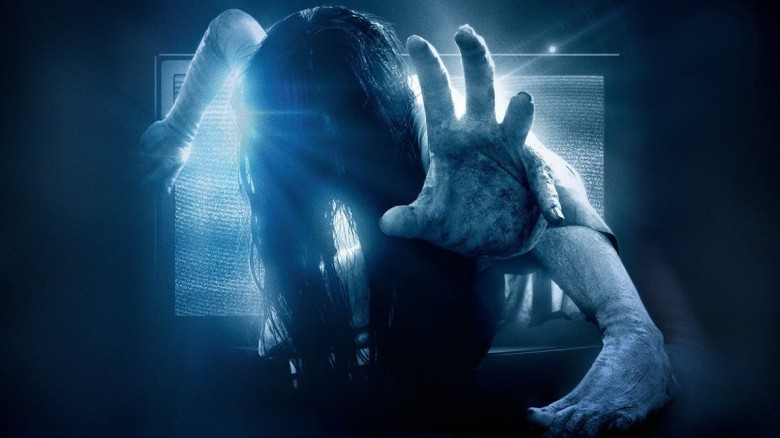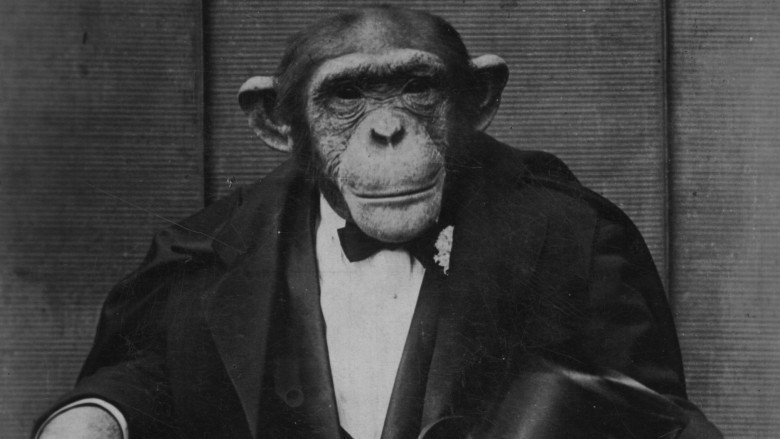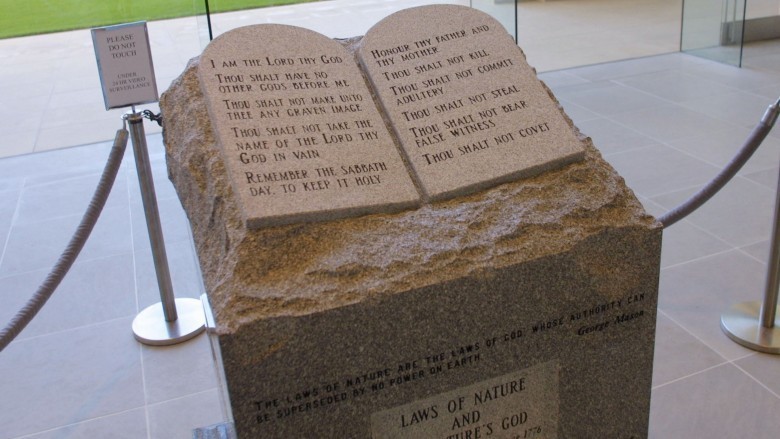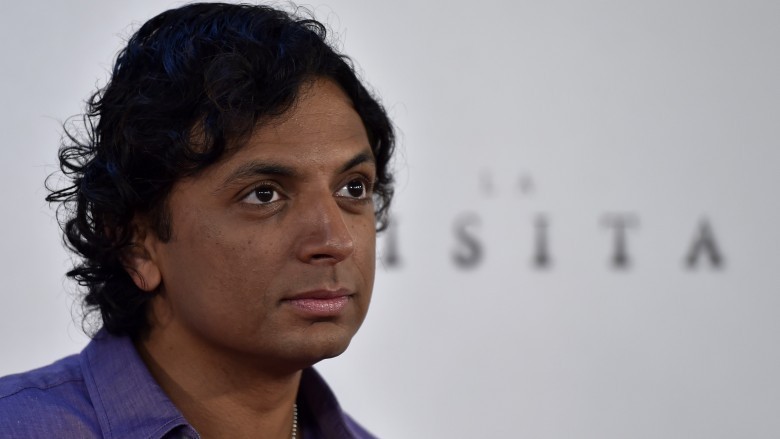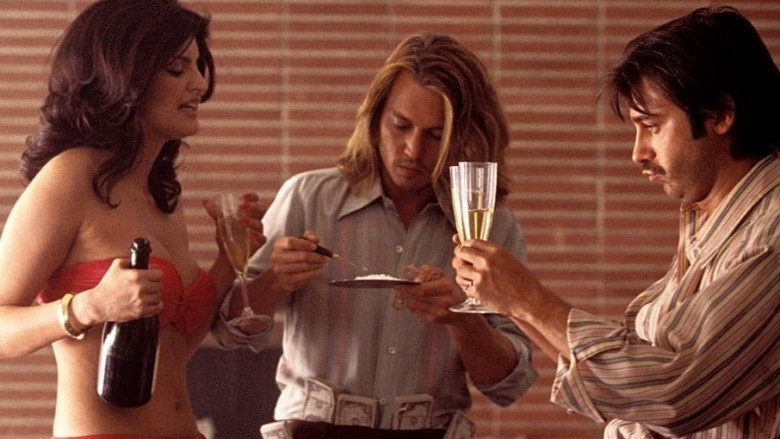Most Ridiculous Ways Anyone Ever Promoted A Movie
Ever since the early days of Thomas Edison and the Lumière brothers, filmmakers have been trying to come up with ways to sell their movies to the public. Usually, that just involves putting out a trailer, but on occasion, studios have gotten pretty creative in the PR department. From fake documentaries to flying lions, Hollywood has pulled some truly ridiculous stunts to promote its movies.
Attack of Thinkmodo
Need to promote your horror movie in the wildest way possible? Call up the guys at Thinkmodo. This three-man team made headlines in February 2017 for their stunt to promote Rings — a gag involving Samara Morgan crawling out of an actual TV screen — but they've been churning out viral videos for years, all involving pranks, monsters, and gullible bystanders.
For example, to promote the (completely unnecessary) remake of Carrie, the Thinkmodo crew set up shop in Manhattan's Nice cafe, rigging up remote-controlled tables, a spring-loaded bookshelf, and a fake wall with a pulley system designed to yank a stuntman across the room. Then, an actress playing an angry telepath used her "psychic powers" to "hurl" the stuntman against the wall, freaking out quite a few customers.
To stir up conversation for Devil's Due, a satanic pregnancy flick, the group placed an evil robot baby in an abandoned carriage on the streets of New York. When concerned citizens stopped to help, the demon child began banging its head, vomiting, and acting like you'd expect a demon baby would. Sticking with the devil theme, the team also terrified customers at a beauty salon to promote a possession film called The Last Exorcism Part II. The gag involved a scary-looking actress behind a two-way mirror, and when unsuspecting patrons checked out their hair, they were shocked to see an evil face glaring back at them.
But perhaps their creepiest caper came while promoting a thriller called Dead Man Down. This particular prank involved two guys in an elevator, one playing a helpless victim, and another a killer, armed with a cord. When the elevator doors opened, people outside panicked, with some running off, others gaping in shock, and a few going into superhero mode, attacking the fake murderer. So if you ever see an abandoned child or murder-in-the-making, you should probably still help out ... but just be prepared to wind up on YouTube for your trouble.
The ostrich egg stunt
Hailed as both "America's No. 1 prankster" and "the last of the great, flamboyant press agents," James Sterling Moran was a genius when it came to grabbing the spotlight. Throughout his career, he performed all sorts of insane stunts, like walking a bull through a China shop, or spending 80 hours searching for a needle in a haystack. And when it came to movies, Moran was rarely equaled among his peers.
For example, in order to promote The Mouse That Roared — a Peter Sellers comedy about the fictional country of Grand Fenwick — he opened a fake embassy and passed himself off as Grand Fenwick's ambassador. But perhaps his greatest stunt came in 1947, when he was drumming up attention for The Egg and I. Starring Claudette Colbert and Fred MacMurray, the film follows a married couple who give up their big city existence for life on the farm. Hoping to promote this Universal comedy, Moran decided to stick with the barnyard theme by hatching an ostrich egg ... and by hatching, we mean he actually sat on the egg himself to keep it warm.
Decked out in ostrich feathers, Moran sat on the egg for over 19 days, until the little chick pecked its way out. The publicity agent named his newborn "Ossip," and in celebration, Moran passed out cigars before declaring he was "eggs-hausted." Unfortunately, Moran was a bit of a deadbeat dad, and instead of raising his new child, he donated Ossip to a zoo. Moran's less-than-egg-cellent parenting skills aside, we can assume this stunt created a lot of good press for The Egg and I, as the movie was so successful, it hatched nine sequels.
Remember the Alamo
John Wayne loved the Alamo. For years, he dreamed of putting this Lone Star story on-screen, and finally, his wish came true in 1960. After an incredibly difficult shoot, The Alamo was ready to go, and Wayne needed it to make a killing at the box office. It had cost around $12 million to make the picture, meaning it was Hollywood's costliest movie at the time. Desperately needing to stir up public interest, the Duke turned to Russell Birdwell, a Texas press agent with a penchant for tall tales.
Birdwell is probably best known for his work on Gone with the Wind. For nearly three years, he oversaw a nationwide talent hunt for an actress to play Scarlett O'Hara. Around 1,500 women tried out, and the stunt kept people talking about the movie until it became the highest-grossing film ever made (adjusting for inflation). Hoping Birdwell could work some of that PR magic, Wayne hired the Texan to promote his own epic, although he probably didn't expect Birdwell to boldly proclaim that the real-life Alamo battle was the "greatest single event" since "they nailed Christ to the cross."
Birdwell was just getting warmed up. Next, he published a massive press kit full of facts meant to wow the public with The Alamo's extravagance. This so-called "Bible" explained how the cast and crew ate 900 gallons of ice cream, needed 10 miles of underground wiring to keep the electricity running, and how they used 40 miles of steel to build the set. He then demanded Congress give the Medal of Honor to everyone who fought at the Alamo, and he even tried to persuade leaders from the U.S. and the U.S.S.R. to hold a meeting at the mission. And after failing to convince Winston Churchill to write a promo for the film, Birdwell attempted to shame Academy members into awarding the film an Oscar by questioning their patriotism.
Sadly for Wayne, The Alamo only won an Oscar for Best Sound, and failed to make its money back. Just like the real-life battle, the movie turned out to be a major disaster.
William Castle's entire career
When it comes to promoting movies, William Castle is the undisputed king. A schlock auteur of the highest order, Castle certainly knew how to draw a crowd, but his stunts didn't stop just because you were safe inside the theater. After luring you in with brilliantly crafted trailers, Castle kept the gag going, throwing all sorts of surprises your way, giving you a full-blown 4-D experience.
The insanity started with a 1958 thriller called Macabre, where Castle struck a deal with an insurance agency to promise a $1,000 life insurance policy to any audience member who died of fright. Adding to the intrigue, Castle parked hearses outside the theater and had fake nurses standing guard in the lobby. Then, for the 1961 horror flick The Tingler, Castle promised the titular monster, a spine-dwelling parasite, would crawl its way into the movie house. And just as promised, there's a scene where Vincent Price warns audiences that the Tingler is on the loose. Even better, Castle rigged up the seats with electronic buzzers, giving moviegoers an extra shock.
In the trailer for Homicidal, Castle assured audiences that if the film got too scary, there would be a 45-second "fright break." But if the movie was just too terrifying, you could get a full refund ... providing you were willing to leave your seat, walk in front of the whole audience, and get your money back at the so-called "Coward's Corner." Castle also encouraged fans to keep the movie's twist a secret, threatening to murder them if they blabbed.
For the creepy Mr. Sardonicus, he promised audiences could vote on the villain's fate, although it seems unlikely Castle actually filmed two different endings. After all, he knew everybody wanted the bad guy to get his just desserts.
Harry Reichenbach, lord of the beasts
Tarzan might be king of the jungle, but even this vine-swinging ape-man needs help surviving in the cutthroat world of Hollywood. So in the early days of film, when studios wanted to promote an upcoming Tarzan picture, they turned to Harry Reichenbach. A press agent with a fondness for animals (or at least a fondness for using them as props), Reichenbach was hired to get people talking about 1918's Tarzan of the Apes. Taking a cue from the title, the PR man got an actual ape, dressed him up in a tuxedo and top hat, and tried to check his primate pal in at the Knickerbocker Hotel. Without a doubt, it was the most adorable publicity stunt of all time.
Things got a bit riskier, though, when Reichenbach was asked to sing the praises of 1920's Revenge of Tarzan. Sticking with wildlife, Reichenbach showed up at another hotel, this time with a sizable crate. After signing in as Thomas R. Zann (T.R. Zann, get it?), the distinguished guest asked the hotel staff to hoist his crate via a pulley system into his hotel room. After the box was safely delivered through a window, Reichenbach ordered 15 pounds of meat. Naturally, this made everyone a tad suspicious. After all, the staff thought "Zann" had a piano in that crate, and it's a well-known fact that musical instruments don't care for steaks.
Moments later, the hotel detective arrived to find that Reichenbach had loosed a lion in his hotel room. Understandably upset, the detective summoned the police, and wherever the men in blue go, reporters will follow. With a captive audience listening to his every word (and watching the lion's every move), Reichenbach was able to give his spiel, encouraging Americans everywhere to spend their hard-earned cash to watch Tarzan get his revenge.
A stunt of Biblical proportions
Adjusting for inflation, The Ten Commandments is the sixth-highest grossing film of all time, beating out movies like Jaws, Avatar, and The Empire Strikes Back. Starring Charlton Heston and Yul Brynner, this Biblical epic tells the story of Moses, how he freed his people from slavery, and eventually ascended Mount Sinai to receive, well, the Ten Commandments. Believe it or not, this 1956 classic was actually a remake of a 1923 film, and both movies were directed by Cecil B. DeMille, a man who liked making big films with big budgets.
DeMille was also fond of making big bucks, so to promote his new Old Testament picture, the director devised an ingenious scheme. During the '50s, a non-profit called the Fraternal Order of Eagles (F.O.E.) believed the commandments could prevent kids from becoming juvenile delinquents. So when DeMille heard about the organization, he proposed an alliance. What if they joined forces to donate granite Ten Commandments to cities across America? These markers could be displayed at courthouses around the country, helping the F.O.E. fight crime and promoting DeMille's upcoming flick.
The Eagles agreed, and soon, the Ten Commandments began popping up everywhere. DeMille even had his two leading men, Heston and Brynner, show up for a few dedication ceremonies. It seems these stone tablets worked wonders, as the movie still regularly plays on TV. Of course, DeMille's little stunt has stirred up quite a bit of controversy, causing headaches for Christian groups and the ACLU alike.
M. Night Shyamalan sees dead people
Sure, it's one of the scariest movies ever made, and yeah, the film crushed it at the box office, but The Blair Witch Project's greatest accomplishment came in the publicity department. Before the movie hit theaters, the filmmakers tricked quite a few people into thinking the story was real. There were the missing posters, the website, and most importantly, the Sci-Fi documentary that made it seem like three people had really disappeared into the Maryland woods.
Evidently, the doc had a big impact on M. Night Shyamalan. Coming off the success of Signs, the director wanted to promote his upcoming creepfest, The Village, so he teamed up with filmmaker Nathaniel Kahn to create his own Sci-Fi special. Titled The Buried Secret of M. Night Shyamalan, the film purported to be an actual investigation into the director's life. As part of the stunt, Shyamalan eventually claimed Kahn was asking too many personal questions, "pulled out" of the project, and started publically attacking the film.
Sci-Fi got into the act as well, conforming Shyamalan's vendetta and handing out false info to journalists. When the documentary finally aired on TV, The Buried Secret claimed Shyamalan had drowned as a child, and after he was revived, he'd gained the power to commune with the dead. In addition to the supernatural aspect, the doc featured quite a few clips from The Village, plugging the upcoming thriller.
Needless to say, people weren't happy. The Buried Secret was slammed in the press, and NBC — Sci-Fi's parent company — was forced to apologize. Adding insult to injury, the doc couldn't save The Village, and soon, Shyamalan's career started to tank. Fortunately, favorable reviews for 2017's Split put him back on track, proving Shyamalan is one unbreakable dude.
Say "yes" to drugs
When Blow hit theaters in 2001, it didn't do super well, critically or financially, but that wasn't for lack of trying. With Johnny Depp and Penelope Cruz at the helm, this drug flick told the story of George Jung, a real-life cocaine dealer with ties to the Medellin cartel. The film doesn't glorify the drug trade, and the movie ends with Jung locked up behind bars. But evidently, the PR team at New Line Cinema didn't get the "coke is bad" memo.
So when the film had its big premiere, New Line rolled out a white carpet for stars to walk down. They even served drinks with glasses coated in powdered sugar. They were going pretty hard with the whole cocaine theme, but that pales in comparison to how they tried to drum up interest among Average Joes.
Shortly before the film came out, the folks at New Line began passing out invitations to advanced screenings, but anyone lucky enough to get an invite also received a complimentary mirror ... you know, the tiny kind that people use to cut cocaine. With the title Blow scrawled across the glass, it seemed like New Line was sending out mixed messages, and not everyone was pleased with their tactics. One unhappy woman claimed the company was "glorying drug use," while the director of a rehab center said the stunt was in "very bad taste."
Whatever your opinion, we can all agree the stunt didn't give Blow much of a bump.
Gunmen in the theater
In 2013, audiences across the world were treated to Iron Man 3. Starring the inimitable Robert Downey Jr., the blockbuster quickly became the tenth highest-grossing film of all time, all while earning the praise of fans and critics alike. But at Goodrich Capital 8 Theaters in Jefferson City, Missouri, the Marvel magic was ruined when patrons spotted a man wearing full-body armor and carrying an assault rifle.
As you might assume, terrified moviegoers called 911, and the police responded in force, ready to take out the gunman. But this wasn't some psycho looking to shoot up a theater. It was all part of the worst publicity stunt ever. Evidently, theater manager Bob Wilkins thought it would be a good idea to hire actors to dress up as S.H.I.E.L.D. agents and greet guests. However, these cosplayers were decked out in bulletproof vests and carrying machine guns, which isn't exactly how we remember Agent Coulson looking in The Avengers.
True, there were guys dressed up as Iron Man and Nick Fury, but that doesn't justify having actors walk around with realistic-looking weapons. Naturally, the stunt drew quite a bit of criticism, and theater officials apologized on Facebook. However, Wilkins also said on TV that he had no regrets about the incident, as it's his job "to entertain people." Making things even worse, all this went down less than a year after the massacre in Aurora, Colorado. Talk about bad timing.
The flight of Leo the Lion
He's one of the most famous stars in Hollywood, and he's not even human. You know him as Leo the Lion, the big feline who appears at the beginning of MGM movies. Seven different cats have played the part, but only one accidentally ended up stranded in an Arizona desert.
In 1927, the heads at MGM decided to put Leo #2 (a.k.a. Jackie) aboard an airplane and fly the beast from New York to San Diego. With "Leo the MGM Flying Lion" zipping through the sky, the executives figured the moviegoing public would eat the stunt up, and then flock to the next MGM film. Eager to put Jackie in the sky, the studio rigged up a special plane with a glass cage, so spectators could glimpse the lion as he soared by, complete with the words "M.G.M. LION" painted on the side of the craft. When the plane took off, heading for sunny California, pilot Martin Jensen made a rather stupid mistake.
Allegedly, Jensen wanted to wave to someone on the ground, so he dove down and couldn't regain control. The plane wound up crashing in an Arizona desert, but thankfully, Jackie was just fine. However, they were stranded in the middle-of-nowhere, so Jensen made sure the lion had water and sandwiches before setting out to find help. Four days later, reinforcements arrived and brought the poor cat back to civilization. Jackie was then dubbed "Leo the Lucky," put aboard a special car, and then forced to tour nearly 40 states for the next three years.
Maybe Leo wasn't so lucky after all.
